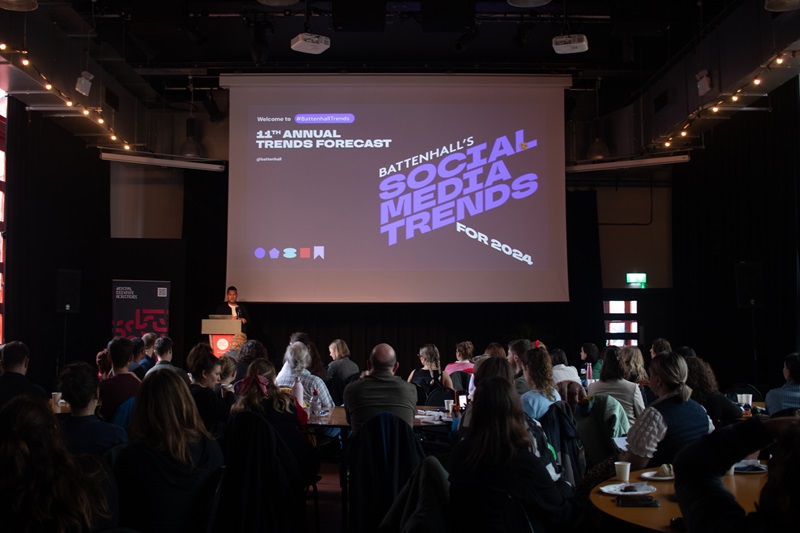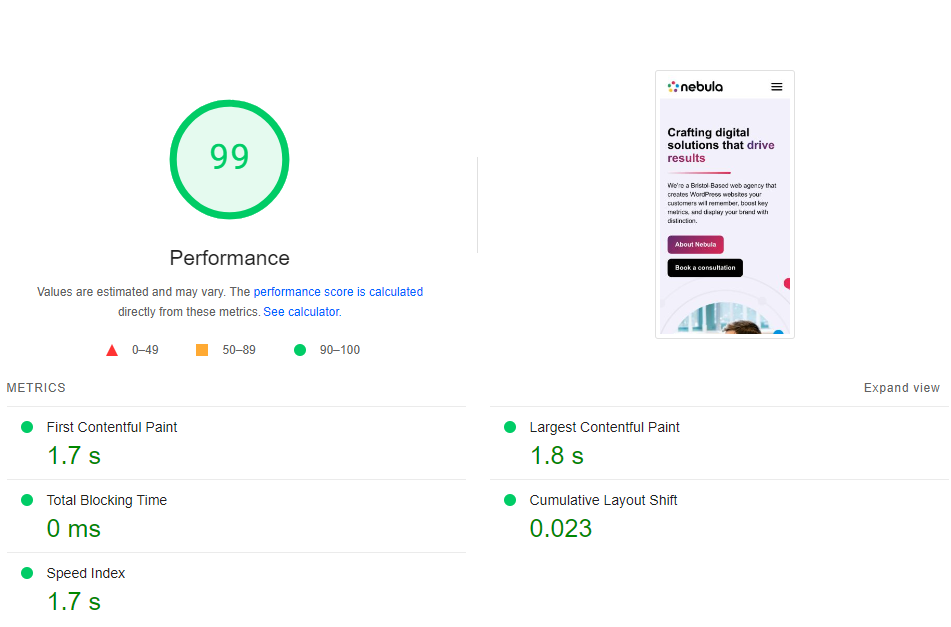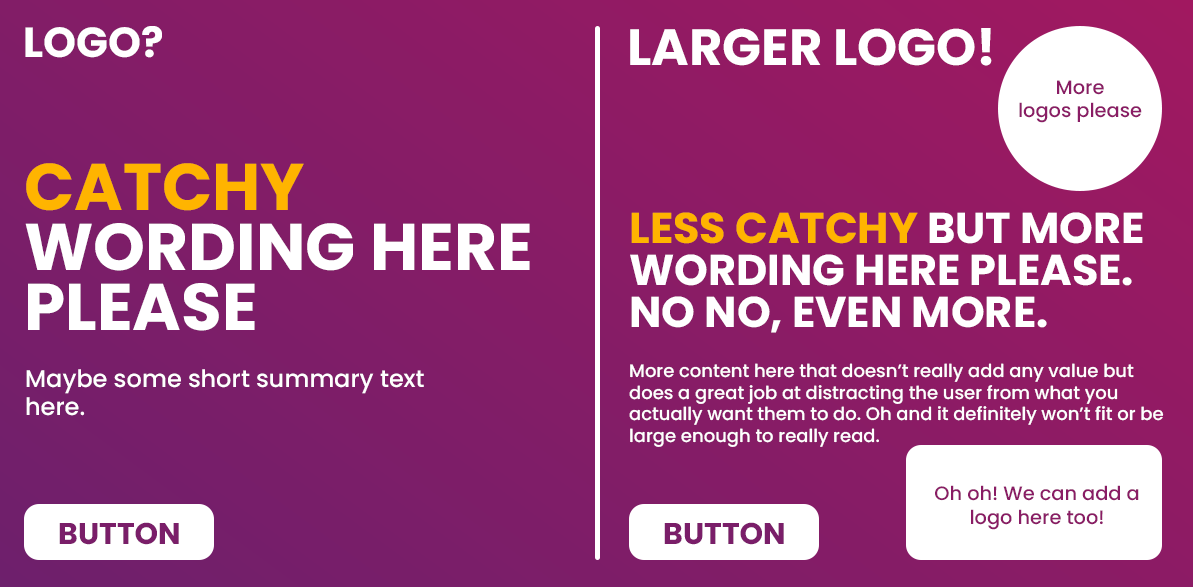Nine Tree Studios in Bristol celebrated their opening earlier this month with an event that saw over 150 attendees from across the creative sector.
The 10,000sq ft facility includes two soundstages for film and photography plus a podcast suite, office space, green rooms and a fully-equipped kitchen studio.
Backed by Bristol-based commercial production company JonesMillbank, the studios have been designed to support both small-scale and broadcast-level productions.
“This has been a long road, but it was amazing to see so many new and old faces, all coming together to support and celebrate our launch.” said Russell Jones, Co-Founder of Nine Tree Studios.
Located in Brislington (BS4), the studios are perched near the centre of Bristol allowing them to service productions mixing studio and on-location filming, aided by its 8,900sq ft secure yard for trucks and trailers.
The studios are now Bristol’s largest independent studio, joining a raft of creative spaces throughout the city including neighbouring virtual production stage Distortion Studios and the established Bottle Yard Studios.
“Like restaurants on a high street, the more there are, the better they are, the more their reputation builds. We’re proud of everything Bristol has to offer and stands for, and the more facilities, talent, crew and creative companies that are based here only goes to benefit the region as a whole” Russell continued.
Nine Tree Studios features:
For more information and bookings please visit www.ninetreestudios.co.uk, call 0117 3706 372, or email [email protected].
Mostly Media, the Bath-based media planning and buying specialists enjoyed recent success at the Independent Agency Awards scooping not one, but two awards.
Hosted by the Alliance of Independent Agencies at the leading worldwide marketing and digital festival ‘MAD//FEST’, this prestigious award ceremony celebrates the finest work across the independent agency sector.
Firstly, for the third time in four years, Mostly Media proudly received the Best Use of Media award, this time for their work on behalf of the UK charity, Crohn’s & Colitis UK.
Secondly, Mostly won the coveted Freedom Award for Client Service, a testament to their exceptional culture and dedication to clients.
Head of Digital Tom Marshall who led the team’s digital campaign commented: “It is a fantastic achievement for such a wonderful cause. To receive the recognition for both Best Use of Media & Client Service was really special, and so well deserved for all the amazing planning and strategic work from the CCUK (Crohn’s & Colitis UK) team, they were amazing to work with on this campaign, so a big thank-you to them for trusting us with this project. Special mention also to the Mostly Team for their brilliant strategy, planning, implementation, and optimisation work – 250,000+ symptom checker completions & delivery of the campaign message to potential sufferers of Crohn’s & Colitis is out of this world!”
Recap of Mostly Media’s Recent Award Wins:
– **2021**: Best Use of Media on behalf of thortful (DTC / Brand Response)
– **2023**: Best Use of Media on behalf of Cawston Press | B-Corp™ (FMCG / Brand)
– **2024**: Best Use of Media on behalf of Crohn’s & Colitis UK (Charity / Performance)
– **2024**: Freedom award for Client Service on behalf of Crohn’s & Colitis UK (Charity / Performance)
About Mostly Media
Based in Bath, Mostly Media is an award-winning top-20 independent media planning & buying agency that prides itself on scaling businesses at pace through media strategy.
Founded on the principles of creativity, agility, and client-focused service, Mostly Media has a proven track record of achieving exceptional results for a diverse range of clients.
With the 2024 general election taking place on 4 July, members of Bristol Creative Industries share what they would like to see for the sector from the next government.
We also outline the specific promises for the creative industries included in political parties’ general election manifestos.
“Everyone is quick to support the creative industries and our contribution in theory, but it’s the delivery of that support in practice that matters. Support means access to funding – proper grants, that actually give companies what’s needed to innovate and accelerate. It’s also about making that funding fully accessible to all.
“It’s been interesting to read the different parties’ approaches to small business in their manifestos (and the lack of focus on it, in some). I like the idea of the FSB’s Small Business Act, particularly measures like making HMRC as helpful as possible, and penalising late paying companies, which can have a devastating impact on smaller firms. Overall, I’m optimistic for change.”
Jessica Morgan, Carnsight Communications
“We’d like to see greater collaboration between the government and educational institutions to develop curriculums tailored to the evolving needs of the PR industry, especially around adopting AI in PR practices.
“We see a real commitment from UK businesses in ESG initiatives and we think the next government should encourage sustainable practices further through incentives for green initiatives and sustainable business operations.
“Lastly, we’d like to see the implementation of economic policies that foster a stable and growing economy, open financial markets, and provide capital to drive innovation after a prolonged period of uncertainty and upheaval.”
Laura Lear, AMBITIOUS
“The creative industry faces two significant challenges: attracting and retaining skilled talent and securing financial support to facilitate investment and growth in a challenging economic environment.
“Many creative businesses are small and agile, enabling them to deliver results with minimal resources. However, for these businesses to reach their full potential, the next government must acknowledge the creative sector’s value and contribution to the UK economy and provide tangible support.
“That means offering tax incentives to small businesses and startups, increasing access to loans and grants – and not just for R&D – expanding and supporting creative apprenticeship programmes, and providing business support programmes specifically tailored for small and creative businesses.
“Finally, we need greater market visibility and opportunities to access national and international trade.”
Catherine Frankpitt, Strike Communications
“Creative businesses are heavily dependent on eduction. Recruitment is not easy and neither is it easy for freelancers and employees to keep their skills current. We need really solid education right from pre-school to continuing professional development.
“The National Education Service proposal in the Labour manifestos of 2017 and 2019 would have worked very well for creative businesses. Unfortunately it doesn’t appear in the 2024 manifesto.”
Adam Nieman, Real World Visuals
“There is a huge gap or opportunity to support creative business owners with better business management training, e.g. mini MBAs for small creative service firms. Most agencies are lead by creatives or technicians, without a grounding in leadership, management, finance, business strategy, marketing etc. and most “get stuck”. Mini MBA type programs, similar to the Goldman Sachs offer and perhaps provided through university business schools would help agency founders to get basics right, to save years of plateauing and enable them to focus on growth rather fire fighting.”
Janusz Stabik, digital agency mentor
“The arts have recently been diminished within education and the national curriculum, so support should be focused around embracing and building back creativity and arts within schools for the next generation of designers and creatives.”
Paul Ellis, Oakwood
“When will any government make 30 day payment terms mandatory across businesses? It would bring a level of certainty of cash flow for creatives across the sector and reduce the amount of wasted time chasing paperwork.”
Neil Sims, Oakwood
“I would like to see a change in pay reporting from businesses to help tackle the gender pay gap. The government states that businesses over 250 people must publish their pay scales, but 98% of the design industry employ less than 50 people. Changing this pay reporting to include smaller businesses will help close the gap, along with other incentives that can help tackle gender pay inequality.”
Alison Harvey, Oakwood
“It was disheartening to read in The Guardian that design and technology could potentially be removed from the national curriculum within four years. This stark possibility underscores the urgent need for immediate government action to support and promote the creative industries.
“To continue building the creative sector, further focus needs to be placed on education, advocacy, and innovation, ensuring the sector not only survives but thrives in a rapidly changing world.
“Education is where it begins. The government must recruit and keep inspirational teachers who can inspire and cultivate the future generation of creative individuals. Quality educators play a crucial role in motivating students and equipping them with the necessary skills to excel in creative industries.
“It’s also crucial to advocate for the creative industry and change outdated perspectives to promote diverse career paths. Traditional career guidance often emphasises professions like policing or accounting, while overlooking the numerous opportunities available in creative industries. It’s important to shift this discussion in educational institutions, as well as with parents and the community, whilst showcasing success stories and the economic potential of creative careers.
“Innovation is at the heart of the UK’s creative accomplishments. For instance, consider Sir Tim Berners-Lee’s creation of the World Wide Web or the iconic design of the Mini car. These examples illustrate the UK’s leadership in problem-solving and generating new ideas. To continue this momentum, the government needs to provide support to creative start-ups, allocate funds for arts research and development, and promote collaborations between businesses and creative professionals.
“So, let’s remember what we’re good at as a nation, continue to nurture it, and constantly innovative, to remain at the global forefront of creativity.”
Ryan Wills, Taxi Studio
“As a specialist SEO agency, we are seeing such transformation with AI powered search and recognise the impact this will have on our clients. We are focused on building our AI innovation expertise and investing in our agency team and talent, so that we are constantly ahead of the curve.
“We are strong advocates that the next government must focus on digital skills education to help prepare our future creative industry workforce. We see investment in digital and AI education, skills, initiatives and training will be crucial for businesses like ours, so we can recruit exceptional talent for the future.
“We believe the next government must also foster collaborations between educational institutions and industry, to help bridge skills gaps and by investing in these, the government can empower and future proof the creative sector to help drive economic growth.”
Tom Vaughton, Varn
“The next government’s priorities should be on building confidence in the economy to support stability and growth, holding businesses to higher social and environmental standards, and supporting arts and creative education to nurture future talent and innovation.
“I also can’t help but mention that being more collaborative, open and friendly with Europe will bring in more opportunities for work and market access, which would be a big win for the creative sector.”
Ed Garrett, The Discourse
“We would like to see an updated approach to skills and training, that includes apprenticeships and skills bootcamps which are better suited to industry’s needs and the types of (self/contract) employment that make up so much of our workforce.
“The current inability of freelancers to access quality extended CPD through apprenticeships is a big barrier to those wishing to upskill and take on new clients & responsibilities.
“We also feel that there is a space for new training solutions that support people with some experience to gain enough skills to be be fully employable. Skills bootcamps are a partial solution but there is a big gap between 60 hours worth of skills training and 12-24 months of an apprenticeship. A mid-way offer that facilitates, for example, a graduate in one discipline to move into another related (e.g. music tech to events technician) one would unlock a huge amount of potential.”
Nick Young-Wolfe, MUTI Live
“The UK represents vast untapped potential for creative businesses. For young people, entry into the industry remains something of a closed shop, achieved via well-trodden paths. Any efforts to broaden these pathways are largely driven by charities or pro bono work by smaller businesses. So we’re undoubtedly missing out on millions of incredibly talented people, and they’re missing out on what could be exceptional careers.
“The incoming government should invest meaningfully in giving the next generation more exposure to what our industry can offer, and easier access to financial and professional support that would make a creative career a viable option for all, regardless of background. Then let’s see what we could achieve!”
Ailsa Billington, Proctor + Stevenson
“The critical area where creative businesses, specifically SMEs, are likely to fall down in the next few years is around developing the digital and emerging tech skills to remain competitive and current. I’m hoping that the new government not only extends its investment of funding for the SME creative community to upskill their teams, but also facilitates better collaborations between business and academia to ensure future training options are both fit for purpose and accessible to businesses of all sizes.”
Lucy McKerron, Purplefish
“Businesses have faced so much disruption and uncertainty in recent years that stability wouldn’t go amiss.
“That’s why, above all else, I’d like to see focus from the next government. I hope this fosters sustainable growth and effective planning, instead of short-term fixes.
“Establishing a supportive environment for green technology, renewable energy, affordable housing, education, and skills is crucial. Running across this is an urgent need to provide sustainable funding for local authorities which stand on the brink of financial collapse.
“These are not ethereal things distant from people’s lives, even if they may not be headline grabbers in themselves. They affect how we live, work and learn.
“Addressing them takes long-term planning. That’s why focus, and purpose, matters. Without it, progress becomes more difficult.”
Ben Lowndes, Distinctive Communications
“Recognise and recompense the creative industries for the contribution to the UK economy and wellbeing. Appoint a secretary of state for culture, media and sport who has worked in business. Provide vital finance for the running of smaller galleries, theatres, museums and music venues. Explore innovative funding models for reducing ticket prices, i.e. an ‘entertainment tax’ for Google, Netflix, energy suppliers etc.
“Reduce bureaucracy for funding applications and encourage collaboration versus competition for industry bodies. Urgently work with business and implement policy to critically improve career access for under-represented groups. Acknowledge that the foundation of the industry is freelancers and review their tax treatment.”
Rachel Lane, Ladbroke Gnomes
“Making Tax Digital (MTD) has been a massive cloud over our heads for about a decade now and we are still not ready for it. I’d like to see more understanding for the creative industries in regards to keeping the threshold at £50,000 turnover before MTD for income tax is compulsory. Creative business owners are not ready, and some don’t even know about it enough to apply everything that comes with it successfully. If it is voluntary, more will come on board without any major issues. It is all about how it is handled rather than enforcing. Make it voluntary or give them more time to provide funded training.”
Yarka Krajickova, Action Your Accounts
Andy Clarke, Huho Consulting
Here are policies specific to the creative industries included in political parties’ general election manifestos:
– “deliver a dedicated flexible coordination service so that everyone who wants to work in the film, TV, gaming and music sectors can work on live productions whilst benefiting from at least 12 months of secure training”.
– ensure creative sector tax incentives “remain competitive”.
– ensure creators are “properly protected and remunerated for their work, whilst also making the most of the opportunities of artificial intelligence (AI) and its applications for creativity in the future”.
– launch a review of England’s nighttime economy, “looking at how to reverse the decline in pubs and clubs and how to make our towns and cities great places to go out”.
– the Conservative Party says “the BBC should represent the perspectives of the entire nation with diversity of thought, accuracy and impartiality as its guiding principles. The party says it “will carefully consider the findings of the Funding Review ahead of the next Royal Charter and ensure it upholds these principles”, and also “introduce a new complaints process for the BBC so the BBC does not mark its own homework”.
Labour’s general election manifesto refers to its ‘plan for the arts, culture and creative industries‘ which it published in March 2024:
– “find the right balance between fostering innovation in AI while ensuring protection for creators and the ongoing viability of the creative industries”.
– make sure that a freelance career in the arts remains a viable prospect through a “New Deal for Working People”.
– seek arrangements with the EU to facilitate easier touring and cultural exchange
– support creative SMEs, and prevent the loss of local cultural spaces through “Space to Create”, “the first national cultural infrastructure map”.
– support arts and cultural organisations “which will enable growth in the wider creative industries by making sure there are pathways from grassroots art and culture to creative careers and support the broadening of audiences”.
– collaborate with the sector, the Creative Industries Council, Arts Councils and other public funders to “create a finance models to attract more funding from different sources into arts organisations”.
– “work constructively to make sure the BBC and our other public service broadcasters can carry on investing in the companies that create distinctive creative output which is exported across the world; and to continue informing, educating and entertaining people across the country for generations to come.”
– launch a review of Arts Council England to consider how best to position the organisation for the next decade.
– introduce the National Music Education Network as a ‘landing point’ for parents, carers and teachers.
– support the museums and galleries sector to make more, high-quality images available for free, and “to bring incredible art and artefacts into communities”.
– tackle ticket touting by capping resale prices and giving the Competition and Markets Authority powers to regulate resale platforms.
– create a National Data Library “to bring together existing research programmes and help deliver data-driven public services…whilst maintaining strong safeguards and ensuring all of the public benefit”.
– support the development of the artificial intelligence sector and remove planning barriers to new datacentres.
– “protect the BBC, S4C, BBC Alba and Channel 4 as independent, publicly owned, public service broadcasters.”
– “promote creative skills, address the barriers to finance faced by small businesses, and support modern and flexible patent, copyright and licensing rules.”
– “negotiate free and simple short-term travel arrangements for UK artists to perform in the EU, and European artists to perform in the UK.”
– establish creative enterprise zones across the UK to grow and regenerate cultural output.
– appoint a dedicated minister of state for tourism and hospitality.
– maintain free access to national museums and galleries.
– apply to participate fully in Creative Europe to improve funding.
– require at least 80% of on-demand TV content to be subtitled, 10% audiodescribed and 5% signed.
– “support independent, Leveson-compliant regulation to ensure privacy, quality, diversity and choice in both print and online media, and proceed with part two of the Leveson Inquiry.”
– pass a “anti-SLAPP law” to “provide robust protection for free speech, whistleblowers and media scrutiny against Strategic Lawsuits Against Public Participation (SLAPP).
– “support the BBC both to provide impartial news and information, and to take a leading role in increasing media literacy and educating all generations in tackling” the impact of fake news.
– implementing the Competition and Markets Authority’s recommendations to crack down on illegal ticket resale.
– “create a clear, workable and well-resourced cross-sectoral regulatory framework for artificial intelligence that promotes innovation while creating certainty for AI users, developers and investors”.
– negotiate the UK’s participation in the Trade and Technology Council with the US and the EU “so we can play a leading role in global AI regulation”.
– invest an extra £5bn over five years for local government spending on arts and culture.
– VAT axed on tickets for local theatre, cultural events and hospitality.
– visa-free access to the EU for UK musicians.
– “implement the 2012 Leveson Report recommendations on cleaning up the media and reinstate the second part of the review.”
– help the night-time economy through a review of planning regulations and giving local authorities the powers to ensure there is space for cultural life.
– push for rules on media to be tightened so that no individual or company owns more than 20% of a media market.
– new grants to encourage the growth of local news publishers.
– introduce a Digital Bill of Rights that “establishes the UK as a leading voice on standards for the rule of law and democracy in digital spaces”.
“push for a precautionary regulatory approach to the harms and risk of artificial intelligence”, and “align the UK approach with European countries, UNESCO and global efforts to support a coordinated response to future risks of AI”.
– “insist on the protection of the intellectual property of artists, writers and musicians and other creators, ensure that AI does not erode the value of human creativity and ensure workers’ rights and interests are respected when AI leads to significant changes in working conditions”
Becoming a member of Bristol Creative Industries brings many benefits. We regularly add new opportunities so here is a guide to the latest benefits you can enjoy by signing up. This post is regularly updated.
Join Bristol Creative Industries from only £4.95 a month.
Showcase your best work and attract new clients with a company profile in the Bristol Creative Industries member directory. The directory receives lots of visits every month from people looking for services from creative businesses.
Got some business advice or news to share? As a Bristol Creative Industries member you can self-publish content on our website and it will automatically appear on your member profile. We upgrade great content to the newsfeed and homepage, while four posts by members are included in our monthly email newsletter.
To get an idea of the content topics that do well, here are the top 20 most popular posts by members in 2022.
Bristol Creative Industries member Jessica Morgan from Carnsight Communications discussed the benefits of posting content in this interview.
The Bristol Creative Industries jobs board attracts thousands of job hunters every month. As part of your membership, you can post unlimited free job adverts, saving you on average £3,500 per candidate.
Piers Tincknell, co-founder of Atomic Smash, is one of BCI’s longest serving members and he told us in a member profile interview how he regularly uses the jobs board to recruit new employees.
BCI’s monthly members’ lunches are a perfect opportunity for members to catch up with fellow members and the BCI team.
Everyone has a slot of up to three minutes to tell the others a little about who they are and what they do and share any news and/or challenges. You don’t need to fill the full three minutes. We usually find some common themes emerge to discuss over the course of the session. It’s all very informal with no need to stand up and present slides.
The events are free to attend for members. They are a mix of in person and virtual events. The in person sessions are at The Square Club in Bristol and include a free buffet lunch.
Check the events section of details of the next lunches.

Our flagship keynote events and workshops feature world class speakers sharing their expertise. It’s a unique opportunity to access valuable insights for growing your business. Bristol Creative Industries members receive a ticket discount.
An example of a keynote event is the brilliant presentation on social media trends delivered in March 2024 by Drew Benvie, founder of global social media consultancy Battenhall.
Some events, such as our regular freelancer networking drinks, are free for members.
Keen an eye on the events section for the latest events. You can also sign up to the monthly BCI Bulletin to be notified of events.
Big thanks to everyone who joined us at @SquareClifton last night for the Bristol Creative Industries freelancer networking drinks ☀️ 🍷
Sign up to the BCI Bulletin to be notified of new events: https://t.co/5WgBWPoN1C#BristolCreativeIndustries #Bristol #freelancers pic.twitter.com/1BvT60KZFp
— Bristol Creative Industries (@Bristol_CI) June 21, 2023
Wake Up Call is a member exclusive live webinar that takes place every other Friday at 8.30-9am. The content is delivered by members for members.
Attending the free event gives you access to valuable insights from your fellow members and if you host a Wake Up Call, you can share your expertise and attract potential new clients.
See details for upcoming Wake Up Call events in our events section.
If you’re a BCI member and you’d liked to deliver a presentation on a topic of your choice during Wake Up Call, email Sian Pitman.
Research shows that diverse teams are more creative problem solvers, bringing fresh perspectives to solutions, against the echo-chamber effect that results when people in a business come from too-similar backgrounds. With a strong focus on diversity and inclusion, employees feel valued and that they belong.
To help Bristol Creative Industries members achieve this, we have partnered with The Hobbs Consultancy to provide on demand equity, diversity and inclusion (ED&I) e-learning.
The CPD certified online course consists of modules to help you bring about positive change in your business, understand the key challenges in the way for different groups, and explore your own biases and how to overcome them.
The training modules take an in-depth look at different diversity and inclusion topics: race, disability, LGBTQ+, neurodiversity, gender (split into female leadership, masculinity, gender identity), age and social mobility in the workplace.
The price of the training for BCI members is £120+VAT. All profits will be ploughed back into our youth engagement activity.
To access this brilliant training opportunity, log into your Bristol Creative Industries account and click on the ‘members’ training’ section.
We have to start engagement at school by raising the profile of the creative sector to a wider and more diverse audience. To do this, we’re developing ways to bring together creative business members and future talent through mentoring.
We are thrilled to have launched a partnership with The Early Careers Foundation (ECF), a social mobility charity that works with young people from low-income backgrounds to ensure that talent and hard work are what determine their career success, not background.
Through its mentoring programme, ECF pairs employees from partner organisations with 16-18-year-olds for monthly hour-long mentoring sessions.
Thanks to our new partnership, BCI members can now become a mentor and support a young person in building their confidence, developing their employability skills and offering invaluable professional guidance.
Applications to become a mentor close on 1 August 2024.
To find out more about how you can get involved, read this post.
The regular BCI Walk & Talk networking sessions are for a group of 12 BCI members who don their walking boots and explore the stunning countryside around Bristol and Bath.
It’s a great opportunity for members to make some new connections whilst getting some much needed fresh air!
Keen an eye on the events section for details of the next outdoor networking event. You can also sign up to the monthly BCI Bulletin to be notified of events.

We host regular roundtables for agency leaders to discuss strategic challenges. These events are vital for us to hear from the member community about the key issues you are facing and how we can help. A roundtable on funding led to us creating this popular and regularly updated guide to the latest finance on offer to creative businesses.
If you are interested in getting involved with future roundtables, email Sian Pitman.
Reductions on co-working spaces, meeting rooms, hotel accommodation, a recruitment strategy review and a coffee subscription are just some of the many discounts and offers we’ve negotiated for members.
We regularly deliver other benefits. To stay updated on the latest member benefits, sign up to the monthly BCI Bulletin.
Join Bristol Creative Industries from only £4.95 a month.
If you have any questions about membership, email Alli Nicholas
All About the Cooks, a website launched in Bristol to enable people to make money cooking from home, has announced that it will close at the end of May. Despite being a runner-up in the BBC Food & Farming Award in 2023 that led to a successful nationwide expansion earlier this year, the company has been unable to find investors to fund the future of the company.
As the company grew, its founder – Claire Ladkin – and her team acknowledged the need for more advanced technology to support the increasing number of cooks joining the platform. A major development that could only be achieved through significant investment.
Over the past few months, Claire reached out to hundreds of potential investors but could not find the right partners to support her vision. She said: “Despite continuous growth in sales and an increasing number of cooks joining the platform, we have found it impossible to secure the money needed to reach our full potential. The current economic climate makes it extremely challenging for companies that focus on consumer-facing products to raise investment.”
On Tuesday, the team of four behind All About The Cooks shared on social media: “We are heartbroken to announce the closure of All About The Cooks. We had big ambitions to make it possible for more home-cooks to make money from their talent and to revolutionise the way we eat at home. Over the past three years, we’ve had the privilege of working with so many incredible people, and we want to say thank you to all our supporters for being part of this journey.”
All About the Cooks will officially shut down its website on the 31st of May 2024. As we continue to witness the weekly closure of Bristol businesses, this adds to the growing list of recent disheartening news.
If you’d like to reach out to the team to show your support, you can contact them at [email protected].
We are delighted to announce that new directors have been appointed to the Bristol Creative Industries board.
The five individuals will deliver additional strength and depth to the board which will hugely benefit Bristol Creative Industries, our members and the wider creative sector in the south west.
They bring a host of skills and experience including digital marketing, film production, CRM, data analysis, website marketing and creative industry education.
As we said in our new year message at the start of 2024, driving value for Bristol Creative Industries members is our top priority, and we remain committed to creating opportunities for our community to learn, connect and grow their businesses.
To continue with this mission, we have key focuses that the new board directors will help us deliver thanks to their excellent expertise and contacts. They will contribute directly to:
Our priorities also include the BCI Talent Programme which supports the next generation of diverse talent in the creative industries and is currently open for sponsorship opportunities.
The appointment of the five new board directors follows Lis Anderson and Heather Wright becoming co-chairs of BCI.
Heather Wright, co-chair of Bristol Creative Industries, said:
“We are delighted to welcome these uniquely talented, inspirational and hardworking industry leaders who have stepped up for BCI and for our sector. They will strengthen our team and make it possible for us to achieve our ambitions for members.”
Joining Lis Anderson, Heather Wright, Gail Caig, Marissa Lewis-Peart, Julian Davis and Steven Coombe on the Bristol Creative Industries board are:

Adam Millbank brings over 16 years of commercial film production experience, serving as a founding director of B Corp registered companies JonesMillbank and Nine Tree Studios.
With his roots in documentary filmmaking, Adam has honed a talent for uncovering the essence of stories, establishing profound connections with his subjects. While he remains a practitioner, he also dedicates significant time to nurturing relationships with agencies and brands, earning him a reputation as a trusted partner in the industry.
Adam now collaborates with globally recognised brands, leveraging his expertise to drive innovative projects.
He maintains a keen interest in the intersection of education and creativity, aiming to foster greater connectivity within the Bristol creative industries around film and video and create a space for collaboration through Nine Tree Studios.

Tom Harber is an experienced creative agency leader specialising in digital experiences and creative technology solutions.
Tom has held leadership positions in industry leading creative agencies across both the UK and Australia that have be recognised at prestigious awards including Cannes Lions, BIMA and The Effies. Tom eventually landed back in the South West to head up creative technology studio, Aer Studios.
Proudly B Corp Certified, Tom and his team have been ranked in the top 100 best workplaces in the UK and have recently been appointed to the BBC UX Design roster as the only agency representing the South West region.
Tom’s passion is in creating meaningful digital experiences that have a positive impact on people and planet. He believes that bringing the creative and technology sectors closer together can have a huge benefit to the South West.

Tom Bowden-Green‘s experience combines senior consultancy (10+ years) and academic leadership (10+ years), designing and delivering training to support business development and career growth in marketing. His current focus is on bringing together regional and academic expertise to support business growth within the creative industries.
Tom studied his PhD at the Digital Behaviour Lab at University of Bath School of Management. His research and teaching now focuses on applying psychology to creative processes.
His recent work at Bristol Business School includes investigating behaviour change with Bristol City Council, researching the Bristol brand with Visit West, and understanding the effectiveness of social media advertising.
Tom created and led the MSc Digital Marketing at UWE Bristol and led several successful Digital Marketing Bootcamps. He co-hosts the The Digital Behaviour Podcast.

David Darke is the co-founder and operations director of Atomic Smash, a website performance agency based in Bristol, specialising in optimising WordPress, WooCommerce and Shopify.
Since its inception in 2010, Atomic Smash has prided itself on a caring team culture, emphasising continuous learning, creativity, and problem-solving. In this role, he has been recognised for kindness in leadership by being nominated as a Kindness Leadership Leading Light.
David’s approach to business reflects a deep understanding of the web’s potential to transform how companies and individuals communicate and conduct business.

Kate Sikora is the co-founder and managing partner of Noble Performs, a digital performance marketing agency based in Bristol renowned for helping organisations achieve remarkable results.
Highly commended as the IOD Director of the Year 2023 and serving as a Taan European Governor, Kate is committed to driving excellence and innovation in the digital marketing landscape.
Beyond her professional endeavours, Kate finds joy in family life, practicing yoga, and exploring new culinary creations in the kitchen.
Bristol based PointZeroGroup has acquired world leading employee experience agency Home.
The acquisition sees Home join a growing network of employee communications and experience agencies in Bristol under the PointZeroGroup banner, further strengthening the city’s reputation as a hotbed for creative brilliance in this field.
The addition of Home to the PointZeroGroup adds employee experience to their service lines for the first time and strengthens their already burgeoning global client portfolio. All group clients now have access to a full suite of employee and candidate propositions.
PointZeroGroup now consist of Home (employee experience and internal comms), RewardPointZero (benefits communications), That Little Agency (social and digital), and BrandPointZero (employer brand). All group agencies are based in Bristol.
PointZeroGroup founder and BrandPointZero Managing Director Andy Bamford said,
“We have admired Home for a long time. Their work in employee experience and internal communications is second to none and a great addition to the PointZeroGroup. They have built an enviable group of experts that we’re now proud to call colleagues. We look forward to collaborating with the team at Home as we grow together in the coming months.”
Home will continue to operate from their office at Unicorn Park, Whitby Road.
In summer 2021 we ran an event discussing funding for creative businesses with the south west team at Innovate UK EDGE and a group of Bristol Creative Industries members.
During the discussion, attendees said it would be useful if we could provide regular updates on the finance schemes that are available for creative companies in the south west and beyond. This guide is our response.
The guide is one of Bristol Creative Industries’ most popular ever blog posts. We keep it updated with the latest funding schemes for creative businesses so check it regularly. We also include the post in our monthy email newsletter, BCI Bulletin. To sign up, go here.
The British Business Bank, the government-owned business development bank, has launched the £200m South West Investment Fund (SWIF) “to help address market failures by increasing the supply and diversity of early-stage finance for UK smaller businesses, providing funds to firms that might otherwise not receive investment”.
Aimed at businesses in Bristol, Cornwall and the Isles of Scilly, Devon, Dorset, Gloucestershire, Somerset and Wiltshire, the fund provides:
SWIF is managed by four fund managers:
The region is split as follows:
North of the region:
South of the region:
The funding is split as follows:
Businesses can apply for funding directly to the relevant fund managers here.
Bristol Council is offering grants of between £2,500 and £10,000 to organisations taking on a new city centre or local high street commercial property.
The funding is open to businesses, charities, CICs, sole traders and arts and culture groups for both long term and temporary/meanwhile use.
Organisations must employ fewer than 50 people, have a turnover of £10.2m or less, and a balance sheet showing £5.1m or less.
Funding can be used for structural works to a property or equipment to be used in the property (capital expenditure). The funding needs to be matched by 20%.
Applications are open until 11.59pm on Monday 30 September 2024.
Successful applicants must start trading from the funded property by Friday 31 January 2025.
UK registered organisations can apply for a share of up to £25m for “game-changing and commercially viable R&D innovations that can significantly impact the UK economy”.
Applications for the latest round of funding close at 11am on 24 July.
UK registered businesses can apply for loans for innovative projects with strong commercial potential to significantly improve the UK economy.
You can apply for a loan of between £100,000 and £2m to fund your project’s eligible costs.
Applications for the latest round of funding close at 12pm on 28 August
This £35m Creative UK and Triodos Bank investment fund provides loans of £100,000 to £1m.
Finance is directed to post-revenue creative businesses presenting promising growth potential and who:
Grants of £50,000 – £150,000 are available for UK registered small and medium sized enterprises with PAYE employees engaged in games development work in the UK.
Established UK-based companies with a game development project at an early stage in the pipeline can apply for grants of up to £30,000.
Applications are open for this government fund which supports rehearsal and recording studios, promoters, festivals, and venues for live and electronic music performance.
Grants of £1,000 and £40,000 are available for projects up to three years in length. The fund runs until March 2025.
This fund from Arts Council England supports individual cultural and creative practitioners in England thinking of taking their practice to the next stage through things such as: research, time to create new work, travel, training, developing ideas, networking or mentoring.
Grants of up to £12,000 are available.
The rounds of funding are as follows:
Round 21
Opens for applications: 12pm on 25 July 2024
Closes for applications: 12pm on 22 August 2024
Decisions announced: 7 November 2024
Round 22
Opens for applications: 12pm on 14 November 2024
Closes for applications: 12pm on 12 December 2024
Decisions announced: 6 March 2025
Travelwest provides match-funded grants for initiatives that improve sustainable travel provision in a business.
The aim is to provide financial support and incentives to employers to enable them to encourage sustainable modes of commuting or in-work travel (including site visits and meetings) amongst their staff.
The grants can be used for the implementation of physical measures, promotional events or any other measure that will encourage mode change amongst staff.
Grants are currently availables for businesses in Bristol and North Somerset.
Innovate UK’s £100m BridgeAI programme aims “to help businesses in high growth potential sectors such as creative industries, agriculture, construction, and transport to harness the power of AI and unlock their full potential”.
The programme offers funding and support to help innovators assess and implement trusted AI solutions, connect with AI experts, and elevate their AI leadership skills.
This fund supports organisations who work at the intersection of art and social change. It offers grants between £90,000 and £300,000 over three years.
The fund is open for applications from 4 April until 31 May and from 14 August until 14 October.
This new £23m social impact investment fund is for socially driven arts, culture and heritage organisations registered and operating in the UK. It offers loans between £150,000 and £1m repayable until May 2030.
The Elephant Trust says its mission is to “make it possible for artists and those presenting their work to undertake and complete projects when frustrated by lack of funds. It is committed to helping artists and art institutions/galleries that depart from the routine and signal new, distinct and imaginative sets of possibilities.”
Grants of up to £5,000 are available.
Grants of up to £100,000 are available for arts, libraries and museums projects.
The grants support a broad range of creative and cultural projects that benefit people living in England. Projects can range from directly creating and delivering creative and cultural activity to projects which have a longer term positive impact, such as organisational development, research and development, and sector support and development.
A Start Up Loan is a government-backed unsecured personal loan for individuals looking to start or grow a business in the UK. Successful applicants also receive 12 months of free mentoring and exclusive business offers.
All owners or partners in a business can individually apply for up to £25,000 each, with a maximum of £100,000 per business.
The loans have a fixed interest rate of 6% p.a. and a one to five year repayment term. Entrepreneurs starting a business or running one that has been trading for up to three years can apply. Businesses trading for between three and five years can apply for a second loan.
If you’re running a creative social enterprise you may be able to access funding from UnLtd.
Finance of up to £5,000 is available for starting a social enterprise and up to £15,000 for growing a social enterprise.
Successful applicants also get up to 12 tailored business support plus access to access to expert mentors and workshops.
Businesses can apply for up to £3,500 to cover the costs of installing gigabit broadband.
Check if the scheme is available in your area here.
If you know of another scheme that we haven’t listed and you’d like to share it with other creative businesses, email Dan to let us know.

You may have a website already, in which case, this article is for you, if you don’t have a website yet, kudos to you for doing some research ahead of time!
Sometimes decisions are solely based on budget alone and that’s okay, so sometimes, it’s great to be able to do things yourself before bringing in the professionals.
The website hacks we’re going to outline below won’t suddenly launch you to the very top of Google, nor suddenly land you thousands of sales. But they will contribute and will get you into the mindset of your audience.
So, get that coffee and let’s begin!
Think from your user’s perspective
This sounds like an obvious one but don’t scroll past this one, here us out. What are your users looking for when visiting your website? Is it your value? Your contact information? Your pricing?
When you get a phone call from a new prospect, what are they typically asking for? Can you find this information on your website?
You need to make sure that information is easy to find on your website and not hidden away – even if it’s content further down the page, you can still link them to it to speed their journey up.
If you’re paying less than £5 a month or less than £60 per year for your website’s hosting – you need to invest more if you want results.
Now, we’re not talking bank breaking amounts here. A good website hosting provider is essentially your website’s foundations. It’s a pointless exercise to invest in improving your website’s user experience when it’s your hosting provider slowing you down.
If you check your current website over at https://pagespeed.web.dev/– what does it score?
If you’re scoring low, it may be that your current hosting provider has you on a shared platform. Whilst simple brochure sites aren’t necessarily demanding, you could be being hosted on an underperforming server to save cost.
Don’t slow your visitors down
To put things into perspective, we pay a little extra for our web server to bundle LiteSpeed Cache (amongst other improvements) – the result? Performance.


If you’re considering putting a pop up on your website, even if it’s just a one-off. I’d like you to visit this website first: https://how-i-experience-web-today.com/
Don’t be mad at me – that’s what your users have to face whilst they’re looking for someone to solve a problem. Stand out by NOT bombarding them with pop ups.

When users visit a website, they’re on a journey following you designed path. By introducing a pop up, you’re actually interupting them and distracting them.
It’s akin to whilst I’ve been writing this article, my phone has pinged several times – 4/5 of the notifications have been absolute nonsense. Go away! The same frustrations apply to your website.
There are so many free tools at your disposal, so before you get your wallet out from from within the sofa, consider some of these handy free tools:

Stop cluttering up your website and embrace whitespace. By reducing clutter and ensuring a good whitespace ratio, you maximise user focus. White space can also make your website feel ‘fresh’, modern and professional.

If you have a lot of content and not a lot of space, consider alternative solutions like accordions or modal pop ups (not to be confused by the earlier intrusive pop ups above).
If you utilise the above guidance of using white space, your calls to action are suddenly going to have a lot more attention on them. Don’t waste this undivided attention with a button that says “Click here”.
Instead, crack open the dictionary and throw down some terminology that’ll get the user clicking. Wording like “Get started now” or “Sign up for free”. Wording like this implies time-sensitivity and/or the value.

There you have it! Some quick website hacks to improve your website, you’re now a pro! Of course these are just 6 quick ‘hacks’, there’s plenty of other improvements that can often be easily applied but they usually depend on your audience and your website’s goal(s).
If you need a hand or would like anything clarified/expanded on, please do feel free to reach out. 👇
saintnicks has been appointed by Ascot Racecourse following a successful competitive pitch process. The win bolsters the agency’s strong start to 2024 alongside retained client growth.
Founded in 1711 by Queen Anne, Ascot Racecourse is arguably the nation’s most revered racing venue, welcoming just shy of 600,000 visitors annually across its 26 race day events. Royal Ascot which takes place 18th – 22nd June, is the most prestigious horse racing event in the UK calendar with more than 300,000 visitors over the 5 day period. Steeped in heritage, Ascot Racecourse is a true British institution and revered national brand.
The two-year contract, which starts with immediate effect, will see saintnicks responsible for Ascot’s overall social content strategy as the brand looks to enhance its reputation further as a global ‘lifestyle’ brand.
Retained as the brand’s lead social partner, saintnicks will work closely with Ascot’s brand, social and content teams supporting with content strategy, content creation and social media management.
Fraser Bradshaw, Founder and CEO of saintnicks says: “We couldn’t be more delighted to partner with Ascot Racecourse and help support their business growth strategy. It’s a brand and business we’ve come to know well over the last few years and we’re invested wholeheartedly in supporting such an iconic national brand as their long term partner.”
Alexandra Bertram, Brand & Creative Lead at Ascot says: “We’re thrilled to embark on this exciting journey with saintnicks as our Social Media Marketing agency. With their expertise and dedication, we look forward to elevating Ascot’s presence in the digital realm. Here’s to a fruitful partnership ahead!”
The appointment follows the re-positioning of the Ascot Racecourse brand and subsequent brand voice development undertaken by saintnicks in 2022.